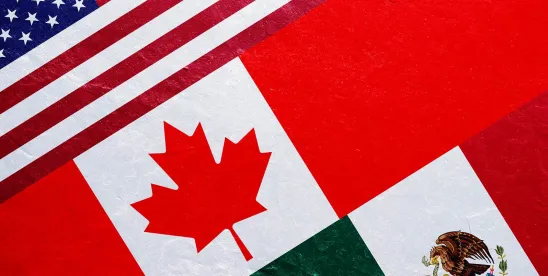On 1 February 2025, President Trump announced that the United States plans to impose additional tariffs on imports from Canada, China, and Mexico to address “the sustained influx of illicit opioids and other drugs” into the United States which is having “profound consequences on our Nation, endangering lives and putting a severe strain on our healthcare system, public services, and communities.”
In sum, the US tariffs will:
- Increase tariffs on goods from Canada and Mexico to 25% (oil imports from those countries will be subject to a 10% additional tariff);
- Increase existing tariffs on imports from China (such as normal customs duties and Section 301 duties) by a 10% additional tariff; and
- Should Canada, China, or Mexico impose retaliatory tariffs, the US tariffs will be increased further.
The US tariffs will go into effect at 12:01 am ET on 4 February 2025. Goods in transit as of 12:01 am ET 1 February will not be subject to the additional tariffs.
Duty drawback will not be allowed on subject imports, and subject imports will not be eligible for the Section 321 “de minimis” exception for small shipments to individual consumers valued at less than $800.
Retaliation by the impacted countries is likely to also take effect shortly, pending a resolution of the disputes.
The text of the first of the Executive Orders (EO) to be released, addressing tariffs on imports from Canada, is available here: https://www.whitehouse.gov/presidential-actions/2025/02/imposing-duties-to-address-the-flow-of-illicit-drugs-across-our-national-border/. A fact sheet issued by the White House explaining the rationale for the tariffs is available here: https://www.whitehouse.gov/fact-sheets/2025/02/fact-sheet-president-donald-j-trump-imposes-tariffs-on-imports-from-canada-mexico-and-china/.
Of particular note for companies and investors with interests in US energy, metals, transportation, and manufacturing markets, the Canada tariff EO defines the scope of “energy” and “energy resources” covered by the 10% duty rate by reference to section 8 of EO 14156 of 20 January 2025. EO 14156, in turn, defines “energy” and “energy resources” as:
crude oil, natural gas, lease condensates, natural gas liquids, refined petroleum products, uranium, coal, biofuels, geothermal heat, the kinetic movement of flowing water, and critical minerals, as defined by 30 U.S.C. 1606 (a)(3).
“Critical minerals” within the meaning of 30 U.S.C. 1606(a)(3), in turn, are currently defined by regulations issued by the US Geological Survey (via determination issued in 2022) as any of:
aluminum, antimony, arsenic, barite, beryllium, bismuth, cerium, cesium, chromium, cobalt, dysprosium, erbium, europium, fluorspar, gadolinium, gallium, germanium, graphite, hafnium, holmium, indium, iridium, lanthanum, lithium, lutetium, magnesium, manganese, neodymium, nickel, niobium, palladium, platinum, praseodymium, rhodium, rubidium, ruthenium, samarium, scandium, tantalum, tellurium, terbium, thulium, tin, titanium, tungsten, vanadium, ytterbium, yttrium, zinc, and zirconium.
Thus, the latest EO has the effect of re-imposing 10% duties on aluminum imports from Canada. It also means that the 25% duties on steel products from Canada have returned (because steel is not currently defined as a “critical mineral.”) In 2018, President Trump imposed tariffs of 25% and 10%, respectively, on steel and aluminum imports from Canada and Mexico under the authority of Section 232 of the Trade Expansion Act of 1962. Those Section 232 tariffs were withdrawn in 2018 following agreements with Canada and Mexico.
Lastly, in a late-night press conference on 1 February outgoing Canadian Prime Minister Trudeau gave some details on the retaliatory measures Canada will take. These will reportedly include 25% tariffs on $155 billion (Canadian) in US imports into Canada. $30 billion of these tariffs will be imposed on 4 February 2025. A further $125 billion will be imposed on 21 February to allow Canadian companies to find alternatives to US sources. The tariffs will be “far reaching” and will specifically target imports that Canada believes to be politically sensitive in the United States, including Canadian imports of US beer, wine, and bourbon, fruits, orange juice, consumer products, appliances, lumber, and plastics. In addition, Canada is considering with the governments of the Canadian provinces and territories several non-tariff measures including several related to critical minerals. Canada is coordinating with Mexico in response to US tariffs. Lastly, Prime Minister Trudeau called for Canadians to avoid purchasing US products and going to the United States for travel.




 />i
/>i
